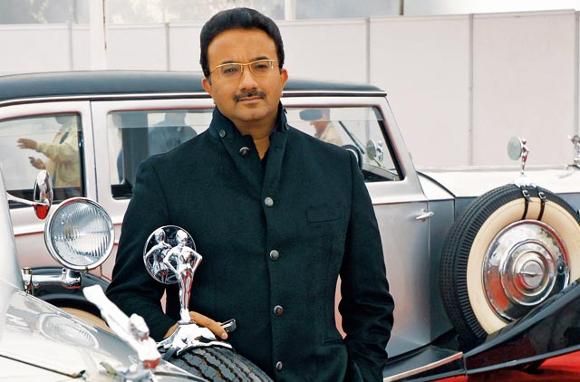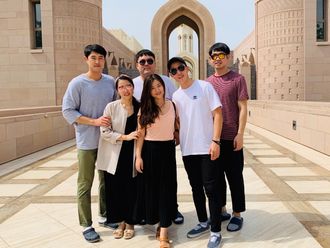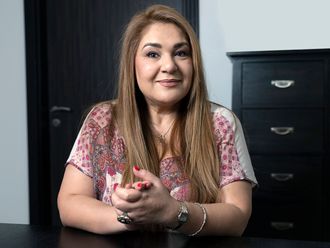
As a boy Diljeet Titus thought cars and not money grew on trees. He would plant dinky cars in his garden in Delhi, India, hoping they would grow into life-size versions. Now, more than 40 years later he is an extremely successul lawyer who at last count owns 82 priceless automobiles – including several that were once owned by erstwhile maharajas.
They are displayed in the Pro Bono Publico Museum for Vintage and Classic Cars, in Mehrauli, on the outskirts of New Delhi – the largest collection of vintage and classic cars in a museum in India where entry is free.
Of course, they didn’t bear fruit from his gardening as a child, but the passion for cars remained undiminished. “So enamoured was I by cars that I was sure they would blossom into trees laden with cars,’’ says the multi-millionaire Indian vintage car lover whose collection of priceless historically-valuable cars have earned him a mention in several respected international publications including Forbes.
Founder and Managing Partner of Titus & Co., a legal consultancy which has clients including 48 Fortune 500 global corporations, Diljeet is hugely successful charging $150 (Dh470) an hour. But even while keeping a busy professional schedule, he stays connected to his cars making it a point to visit the museum almost every day. And the car in his collection that undoubtedly takes centre stage is the Belgian Minerva Type AL.
Made in 1933, it’s a priceless gem – only nine of them exist in the world today. “This is the only such car you will ever get to see in the whole of Asia,’’ says Diljeet proudly, gently flicking a speck of dust off the car’s bonnet.
“It was owned by Raja Mohammad Amir Ahmad Khan of Mohammadabad in Uttar Pradesh, northern India. Only 33 of these exquisite cars were produced and just eight are known to exist today.’’ One is with the King of Belgium, six with private collectors in the United States and Titus owns the eighth.
“A 40 HP model powered by a 6616cc 8-cylinder engine with sleeve-valves, custom-built in Belgium by Minerva Motors SA for the Maharaja of Mehmudabad, the car features gold-plated instrument bezels and switches,’’ he says walking around the museum he set up “so anybody who is interested in cars or history could come by and enjoy these beauties.’’
India’s love affair with automobiles is more than a century old. “The first car was imported in 1901 by industrialist Jamshedji Tata and in the years that followed, maharajas and nawabs acquired some of the finest cars in the world including Rolls Royces, Bentleys, Jaguars, Diamlers, Maybachs, Mercedeses, Bugatis and Cadillacs,” says Diljeet.
But while the maharajas settled for maybe three or four vehicles, Diljeet has no wish to restrict the number of cars he wants to own.
“My endeavour is to keep the heritage of these vintage and classic beauties alive, as they have been part of royalty,” he says.
Titus grew up with Ambassadors, Fiats and Standard Heralds at home.
“My grandparents owned Chevrolets and Austins and I began driving cars inside our compound at the age of 11,’’ he recalls.
“But since I couldn’t drive on the roads, I used to spend my free time cleaning cars at home or accompanying the drivers when they took it to the garages for servicing or repairs. I wasn’t hugely interested in the Ambassadors and Fiats, but in classics like the Packards, Cadillacs, Buicks and Rolls Royces. These used to stand out from the crowd.”
Growing up, Titus followed in his grandfather’s footsteps and earned a degree in law before joining a law firm called Singhania & Co in Delhi where he worked from 1989 until early 1997.
However, keen to set up a law firm of his own, he and four of his friends set up Titus & Co in 1997 now considered one of the leading firms in the country. In fact Diljeet was named one of Asia’s best lawyers by Asia Law, a website that provides news and analysis for the legal community in Asia-Pacific, for two consecutive years (2002-03).
So successful was he that in two years he was able to start realising his dream of collecting vintage cars.
“The cars manufactured from 1919 till the end of 1939 are generally called ‘vintage’ cars while cars made between 1940 and 1969 fall under the ‘classics’ category,’’ he explains, lovingly caressing a 1948 Austin A-40 which he says his grandmother gifted him.
“She knew I was very fond of this car and she gave it to me in 1999.’’
That in many ways set the ball rolling and Diljeet began to scout around keen to acquire more vintage cars.
“I began reading up all I could on the history and heritage of classic cars and even today enjoy spending time scouring libraries and book stores for books on the subject,’’ he says.
“Once I began to learn more about the history of classic cars in India, I began to seek them out – scouring garages and contacting people who owned them.
“One day in 1999, I was sitting in the balcony of my house in Delhi when I saw a Hillman Minx being towed away. I literally ran down the road and enquired about the address of the owner and called him up. After a bit of haggling, the owner happily parted with it,” says Diljeet, refusing to divulge how much he picked it up for.
“The idea to set up a museum came to me in 2003 when I had collected about seven cars,” he says.
Not wanting to see them just parked in his house where only a few could admire them, he decided to set up a museum in the farmland he owned in Mehrauli where he could display his prized possessions for all to come and see and “learn more about the fabulous history of vintage cars in India’’.
He has employed a team of five mechanics paying them around Rs20,000 each per month to maintain the cars. “Most of these cars when bought are in a pitiable condition. Unused and uncared for by their owners, they need lot of looking after. After buying a car, I first overhaul its entire mechanism, including the engine, gear box, brakes, suspension, electricals and change the windhsheilds and upholstery. A good paint job and it is ready for the museum,” he says.
Restoration can cost anywhere between Rs 2 lakh and Rs7lakh depending on the condition of the car, he says.
“Those who drop by to see the collection of cars have some questions about the origin and history of my prized possessions that sometimes stump me. So I have started compiling a brief dossier on each car, including its history, the model and the previous owners,” he says.
Apart from vintage and classic cars, the 6,000 sq ft museum also houses some of his SUVs (like the 4.2l turbo charged diesel Toyota Land Cruiser, Land Rover, Prado to name a few) for his daily use.
During his initial years of collecting, Diljeet used to buy almost every vintage or classic car that came his way, but over the years, he has become more picky. “It’s like an art collection, which needs to have rare and worthy pieces. The vehicles I now buy are those that were custom-built, had low mileage and documented provenance.”
This explains the varied and striking collection of a large number of cars that were earlier owned by maharajas, including two Rolls Royces, several historic Packards and Cadillacs, the only Stutz in the country, a Minerva, a Pierce Arrow and an Auburn.
One of his personal favourites include a Stutz (1930).
The 1952 Cadillac, Series 62, which was owned by the Maharaja of Barwani, in Madhya Pradesh, central India, and then by the Maharaja of Tehri Garhwal, in present day Uttarakhand, is another prized possession. “This was Cadillac’s Golden Anniversary model and was characterised by a distinct, higher rear deck lid contour,’’ says Diljeet. Standards included self-winding clocks. “The 5422CC V8 engine produced 190hp and has power steering which makes it a pleasure to drive. This model was referred to as 6237 DX.’’
Then there’s the 1959 Cadillac Sedan de Ville, previously owned by Maharaja Gaj Singh of Jodhpur, Rajasthan. Its standard features included automatic transmission and power-steering, brakes, windows and locking. Also included were an air-conditioner, tape player and radio. “No single automotive design better characterises the industry’s late 1950s flamboyance than this Cadillac, which incorporated totally new styling.’’
Then there is the 1935 Buick Series 90, Model-L. This was previously owned by Raja Saheb of Ayodhya. Only 191 of these seven-passenger limousines were produced in 1935.
Diljeet’s cars have been used in several Bollywood movies including the hugely popular Chashme Budoor, Zubeida and more recently Black.
According to Diljeet, until 1947, the rulers of the princely states were the biggest patrons of luxury cars. A fourth of the Rolls Royce production fed the Indian market between 1912 and 1947. But with the soaring demand, General Motors set up an assembly line unit in Mumbai way back in 1927. It produced around 11,000 cars, including Buicks, Chevrolets and Vauxhaulls in the next decade.
However, after Independence in 1947, most of these cars were smuggled out of the country to feed the huge demand of vintage car collectors’ market in the US and Europe. But fuelled by a new kind of demand for these priceless objects back home, prices of these cars have doubled in the past few years.
Experts say, not more than 1000-3000 vintage cars exist in the country today. These could be valued at Rs.3.5 billion. Some of these have found their way into the villages and havelis across the country.
Although Diljeet has scores of them, he says, “I am constantly searching for more.”
Diljeet says he is fortunate to have married his childhood sweetheart Anurita, who assists him in his selection of vehicles and plays an important role in choosing colours to paint them. The couple has two daughters Shekinah, 16, and Diyasannah, 14, both of whom are also fond of the colourful and chic cars.
Diljeet is constantly on the lookout for more cars. Yes, apart from friends who sound me out on cars they have spotted I also keep a watch out from my balcony occasionally .. just in case I find a vintage car,’’ he says.












